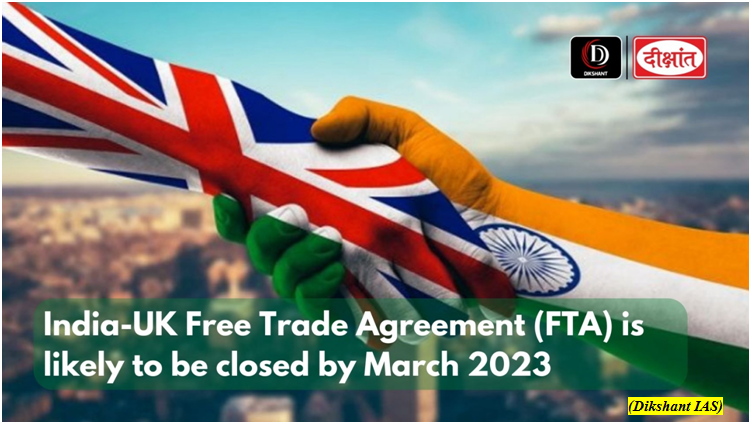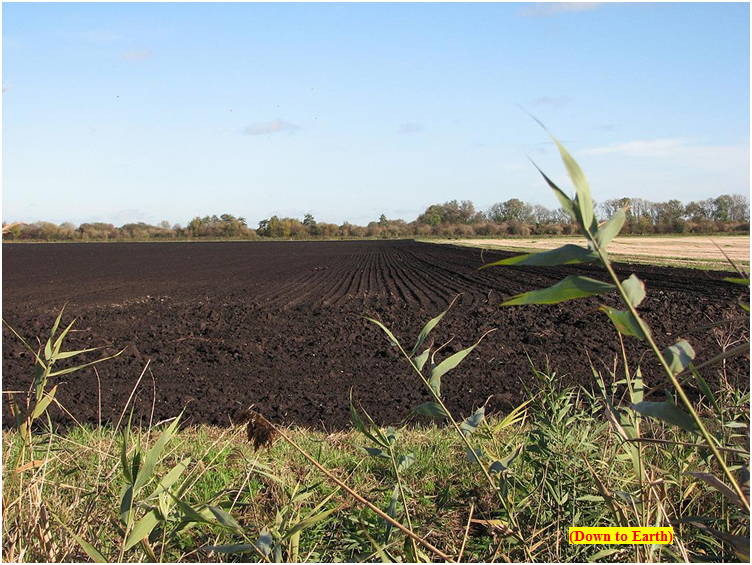India-UK Free Trade Agreement (FTA) is likely to be closed by March 2023 (GS Paper 3, Economy)

Why in news?
- The ongoing negotiations for the proposed free trade agreement between India and the UK is likely to be concluded by March 2023.
Background:
- India-UK FTA negotiations began formally in January 2022.
- India and Britain launched negotiations for the free-trade agreement (FTA) in January with an aim to conclude talks by Diwali (October 24), but the deadline was missed due to political developments in the UK.
- There are 26 chapters in the agreement, which include goods, services, investments and intellectual property rights.
Political causes of delay:
- The Diwali deadline for an FTA was set by PM Boris Johnson. He had been plagued with political scandals had his term cut short and was followed by Liz Truss after she won a Conservative Party leadership contest that enabled her to fill the prime ministerial role.
- Truss had defeated Rishi Sunak, Chancellor in PM Johnson’s cabinet. PM Truss herself resigned on October 20, having lasted barely 44 days in office.
- Rishi Sunak subsequently became prime minister on October 25 as his bid for Conservative Party leadership went uncontested.
What’s at stake?
- The UK is keen to gain India market access for transport equipment, electrical equipment, medical devices, chemicals, motor vehicles and parts, wines, Scotch, and spirits, some fruits and vegetables which could impact local industry players and/or boost the manufacturing ecosystem.
- On its part, India wants to increase exports of textiles, food and beverages, pharmaceuticals, tobacco, leather and footwear, and agricultural items like rice to the UK. Digital services and ICT sectors will also benefit and drive the expansion of bilateral trade under the FTA.
Recognition of academic qualifications:
- Mutual recognition of academic qualifications and duration of study in recognized and approved higher educational institutions in both countries will ease movement of professionals across the two markets.
- For example, Indian senior secondary school and pre-university certificates will be recognized for entry into the UK’s higher educational institutions. However, the MoU on education does not cover professional degrees, such as engineering and medicine.
MoU on maritime education:
- The MoU in maritime education will ensure mutual recognition of certificates of “maritime education and training, competency and endorsements of seafarers issued by each side”.
- India is among the top suppliers of seafarers in the world, and this India-UK MoU opens job prospects in the British shipping sector.
Recruitment for British healthcare sector:
- Recruitment of Indian nursing and allied health professionals for the UK healthcare sector will benefit from the Framework Agreement on Healthcare Workforce.
Bilateral trade:
- The bilateral trade between the two countries increased to $17.5 billion in 2021-22 compared to $13.2 billion in 2020-21. India's exports stood at $10.5 billion in 2021-22, while imports were $7 billion.
Way Forward:
- While India seeks a March 2023 conclusion to the deal, discussions on sticky issues in the next round of talks will determine whether this is possible.
World Bank raises Indias growth projection to 6.9%
(GS Paper 3, Economy)
Why in news?
- Recently, the World Bank released its latest India Development Report titled ‘Navigating the Storm’.

Details:
- It lifted its growth forecast for India’s economy in 2022 to 6.9%, after having downgraded it to 6.5% in October.
- It revised the GDP forecast considering the strong upturn in the July-to-September quarter of 2022-23, when it grew 6.3% despite inflationary pressures and tighter financing conditions, “driven by strong private consumption and investment”.
- The government’s focus on bolstering capital expenditure also supported domestic demand in the first half of 2022-23. High frequency indicators indicate continued robust growth of domestic demand at the start of Q3 (October to December quarter).
Key Highlights:
- The Bank expects the Indian economy to grow at a slightly slower 6.6% in 2023-24 as a challenging external environment and faltering global growth will affect its economic outlook through different channels.
- The report said that while a one percentage point decline in growth in the United States is associated with a 0.4 percentage point decline in India’s growth, the effect is around 1.5 times larger for other emerging economies, and the result is similar for growth spillovers from the EU and China.
Trade deficit:
- Strong revenue growth would largely offset India’s higher subsidy bill and lower fuel taxes, but these measures have slowed the pace of fiscal consolidation.
- The confluence of multiple challenges on the external front poses a challenge to India’s growth trajectory, but balanced policymaking, which factors in these trade-offs, will help India navigate global headwinds.
- A widening goods trade deficit, driven by rising imports and softening exports, has expanded India’s current account deficit to 2.8% of GDP in Q2 this year from 1.5% in the first quarter. India scores better than only the Philippines and Thailand on this metric of macroeconomic stability.
India’s forex reserves:
- Despite an over 10% dip in India’s forex reserves in 2022, they are still over $500 billion and provide adequate buffer against global spillovers” with an import cover of at least eight months.
- Since the taper tantrum in 2013, India’s forex reserves have almost doubled and provide better coverage of external debt than other emerging market economies.
Challenges:
- The report, cautions about trade-offs between trying to limit the adverse impact of global spillovers on growth and the available policy space.
- Like its COVID-19 response, the Indian government’s response to the external shock combined demand-side and supply-side policies, with both fiscal and monetary policy levers deployed.
- While there are still some challenges in the financial sector, the adoption of several regulatory and policy measures including introduction of a new Insolvency and Bankruptcy Code and creation of the new National Reconstruction Company Limited facilitated an improvement in financial sector metrics over the past five years.
Black soil in red Climate change threatens worlds food basket
(GS Paper 1, Geography)
Why in news?
- On the occasion of World Soil Day (December 5), the Food and Agriculture Organization (FAO) released a report on Global status of black soils.
- Black soils, which feed the global population, are under threat, with most losing at least half of their soil organic carbon (SOC) stocks.

Black soils:
- These soils are characterised by a thick, dark-coloured soil horizon rich in organic matter. Most of the black soils suffered from moderate to severe erosion processes, as well as nutrient imbalances, acidification and biodiversity loss, the report said.
- Black soils are extremely fertile and can produce high agricultural yields thanks to their elevated moisture storage capacity.
- They constitutes 5.6 per cent of global soils and contain 8.2 per cent of the world’s SOC stocks: Approximately 56 billion tonnes of carbon.
Significance for climate change mitigation and adaptation:
- This signifies their importance for climate change mitigation and adaptation. The ability of the soils to remove carbon from the atmosphere and lock it up in soil organic matter (called carbon sequestration) has been proposed as an important solution to mitigate human-induced climate change.
- However, black soils are quickly losing their SOC stocks. They have lost 20 to 50 per cent of their original SOC stock, with the carbon being released into the atmosphere mostly as carbon dioxide, exacerbating global warming.
Potential
- Black soils have the potential to provide 10 per cent of the total SOC sequestration globally if they receive proper attention. Europe and Eurasia have the highest potential at over 65 per cent and Latin America and the Caribbean at around 10 per cent.
- Black soils were home to 2.86 per cent of the global population and had 17.36 per cent of cropland, 8.05 per cent of global SOC stock and 30.06 per cent SOC stock of global cropland.
- However, despite representing a small portion of the world’s soils, black soils were key for food security and the global economy.
- Globally in 2010, 66 per cent of sunflower seeds, 51 per cent of small millet, 42 per cent of sugar beet, 30 per cent of wheat and 26 per cent of potatoes were harvested from black soils.
- The distribution of black soil areas used as croplands varied in each region. Europe and Eurasia accounted for 70 per cent of the soil in the total cropland, while North America, Latin America and the Caribbean and Asia had 10 per cent each.
Way Forward:
- The inherent fertility of the soils make them the food basket for many countries and are considered essential to the global food supply.
- Preserving natural vegetation on black soils such as grasslands, forests and wetlands and adopting sustainable soil management approaches on cropped black soils are the two main goals highlighted by the report.
Code of Criminal Procedure (Gujarat Amendment) Bill, 2021
(GS Paper 2, Governance)
Why in news?
 Bill, 2021.png)
Background:
- The Code of Criminal Procedure (Gujarat Amendment) Bill, 2021 was passed by the State Assembly in March 2021.
- It was sent to the Ministry of Home Affairs (MHA) to examine if it was repugnant with any central law or deviated from the Central government’s policy.
- The clearance to the amendment comes at a time when the Ministry is actively working to overhaul the Indian Penal Code (IPC) and the CrPC to remove any colonial baggage from the codes.
- After holding inter-ministerial consultations, the MHA gave an opinion to process the bill, following which it was signed by the President, paving the way for it to become the law in Gujarat.
Key Highlights:
- The bill seeks to make any violation of prohibitory orders issued under Section 144 CrPC, a cognisable offence under Section 188 of the IPC (disobedience to order duly promulgated by public servant).
- It amends Section 195 of the CrPC, which states that no court shall take cognisance of any criminal conspiracy for contempt of lawful authority of public servants, except on the complaint in writing of the public servant concerned.
- The statement and objects of the bill said that the Government of Gujarat, Commissioners of Police and District Magistrates are empowered to issue prohibitory orders under Section 144 of the CrPC directing any person to abstain from certain act or to take certain order to prevent disturbance of public tranquility or a riot or an affray to maintain public order on various occasions.
- It said that police officers while deployed on such duties come across incidents of violation and need to take appropriate legal action against the violators under Section 188 of the IPC.
Section 188 of the IPC:
- Section 188 IPC was invoked liberally by police across the country on the directions of the MHA during the COVID-19 induced lockdown years of 2020 and 2021.
- In those two years, the number of cases registered under the said section stood at 6.12 lakh and 3.22 lakh respectively, a sharp jump from the 29,469 and 22,907 cases registered in 2019 and 2018 respectively.
- The maximum punishment under the Section is six months imprisonment.





 Bill, 2021.png)